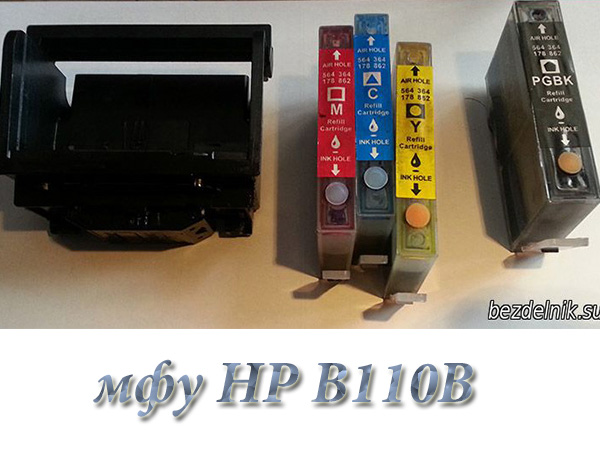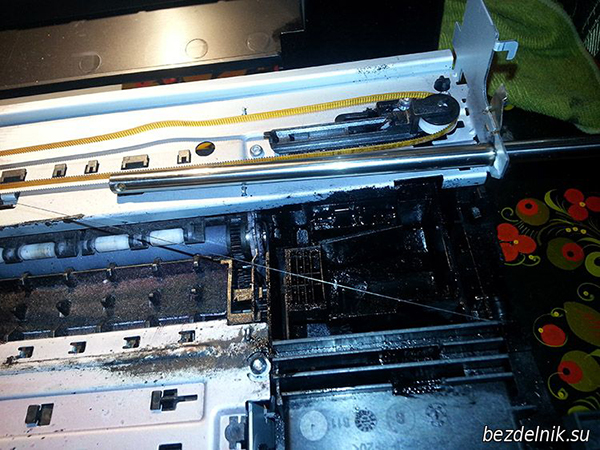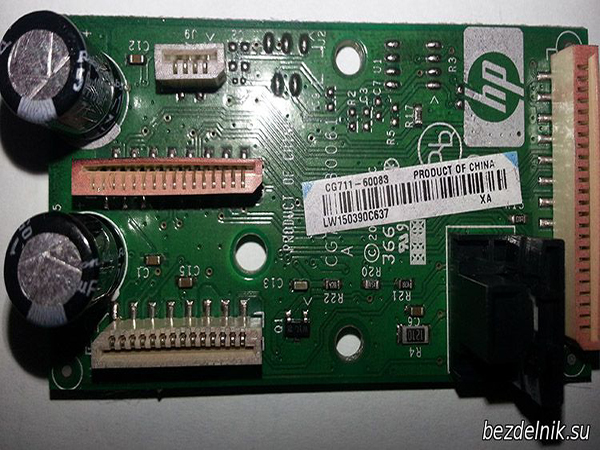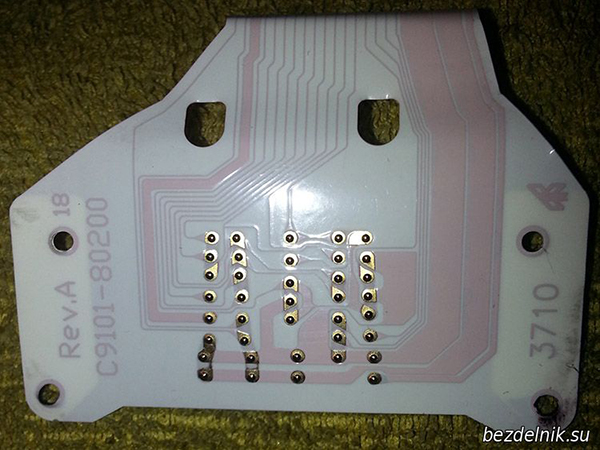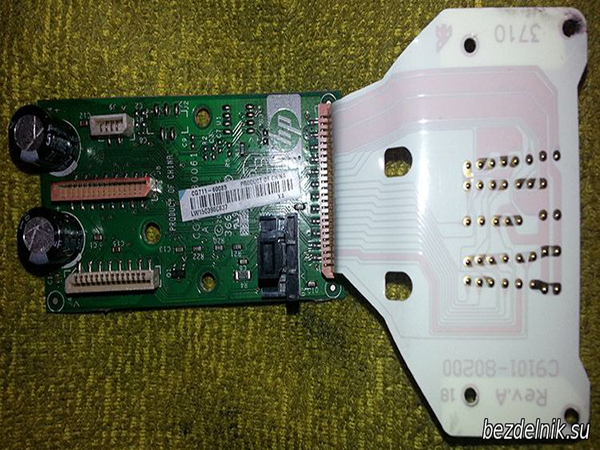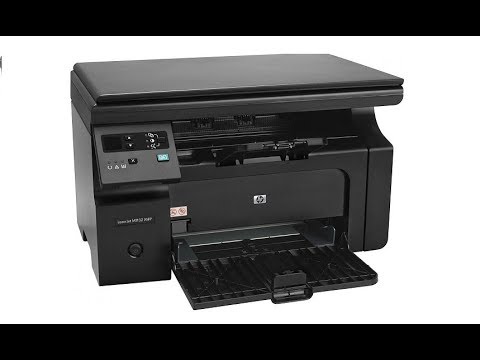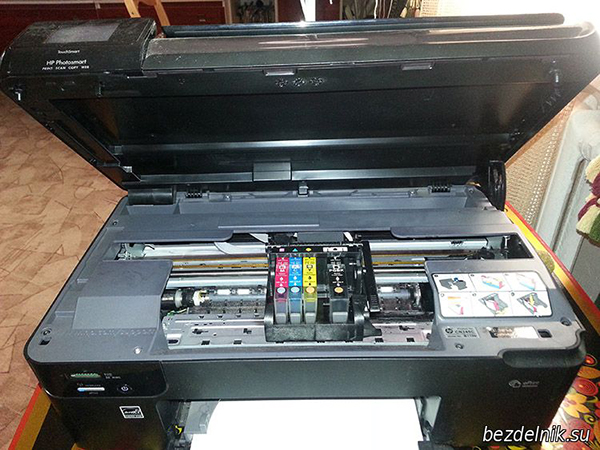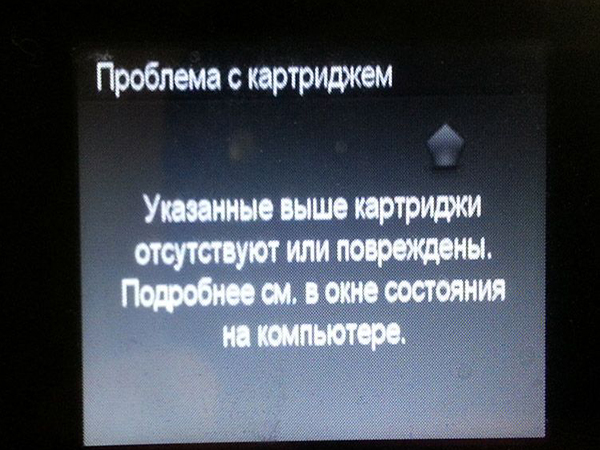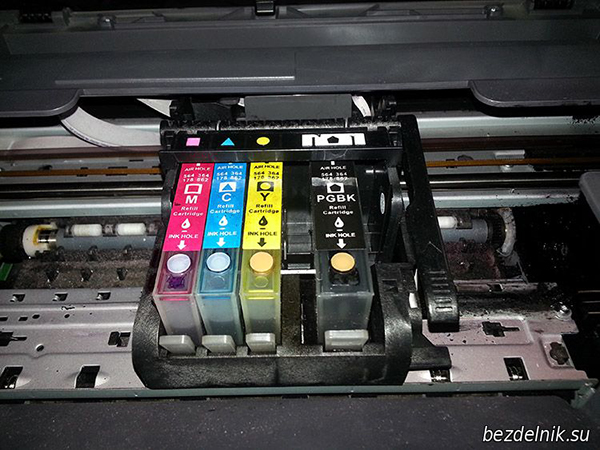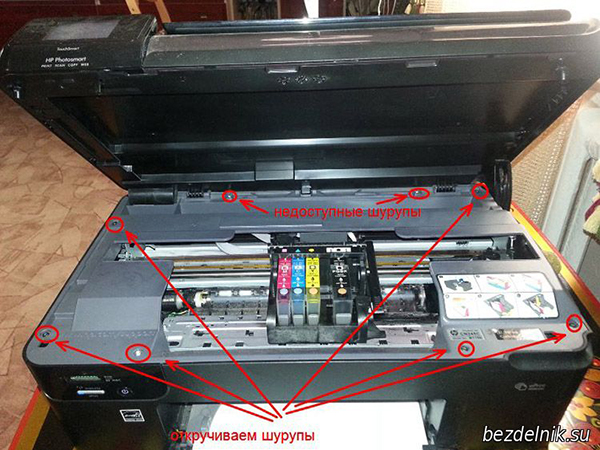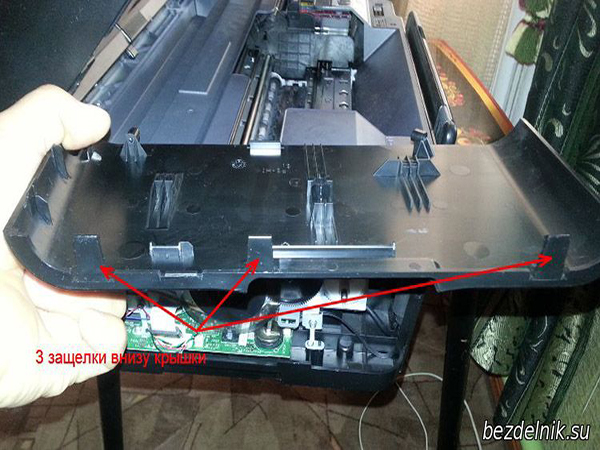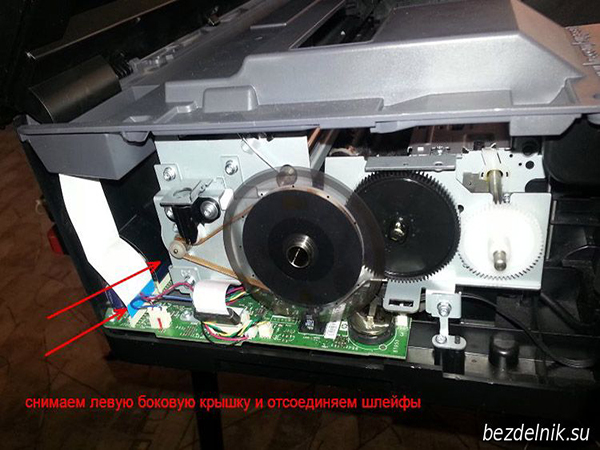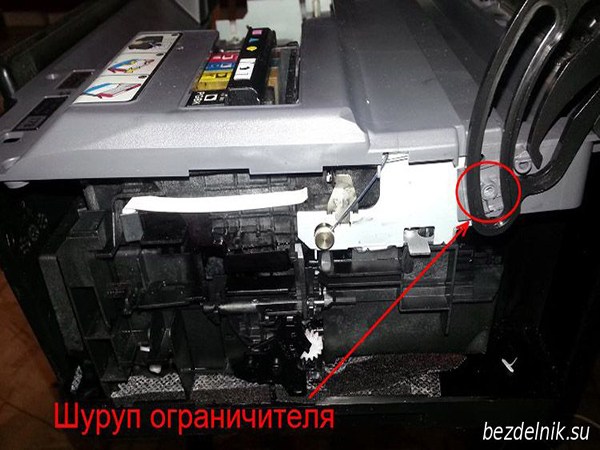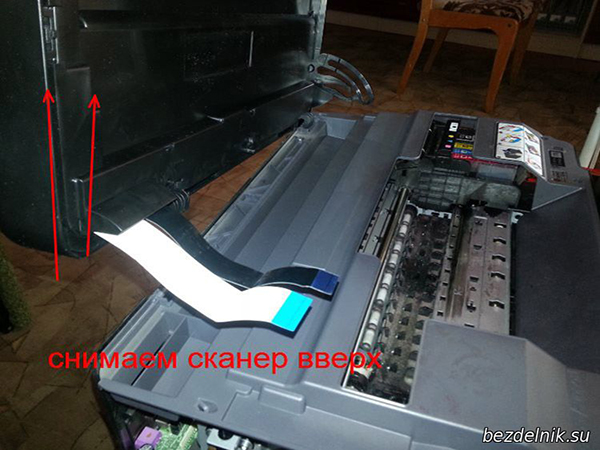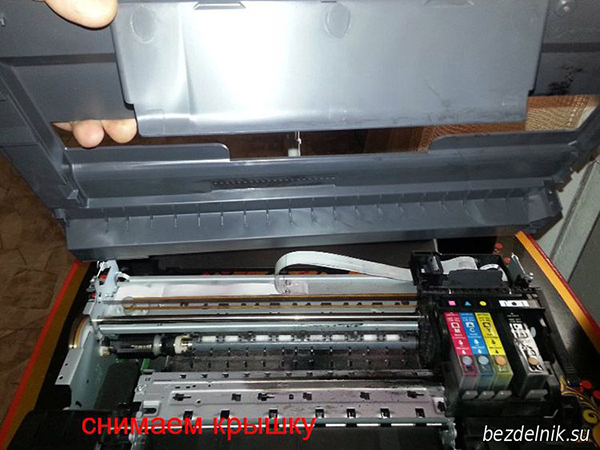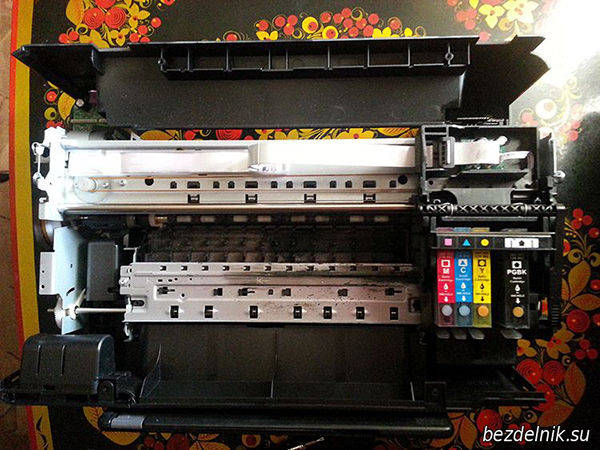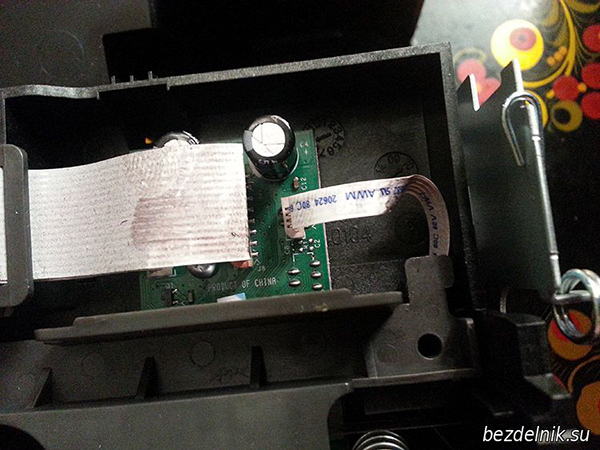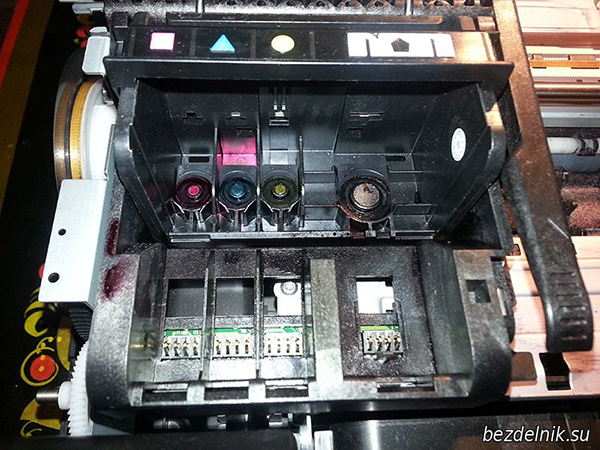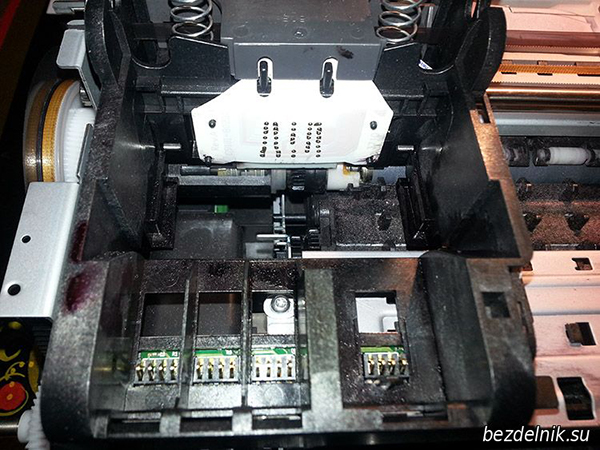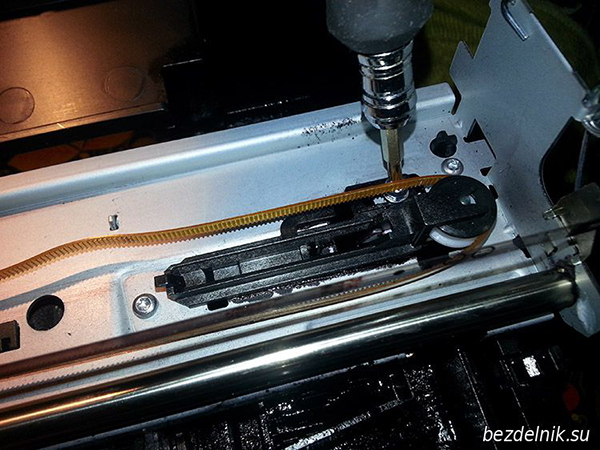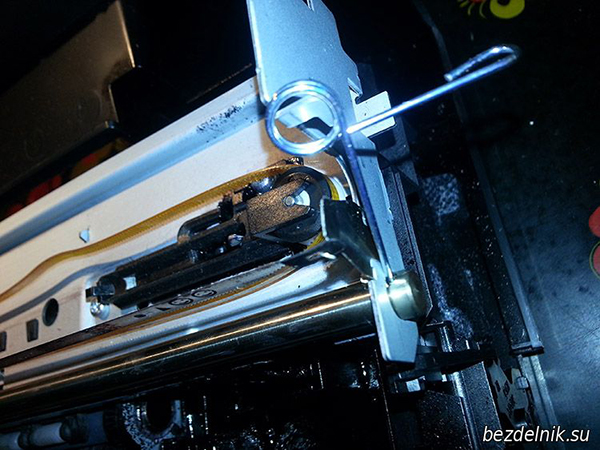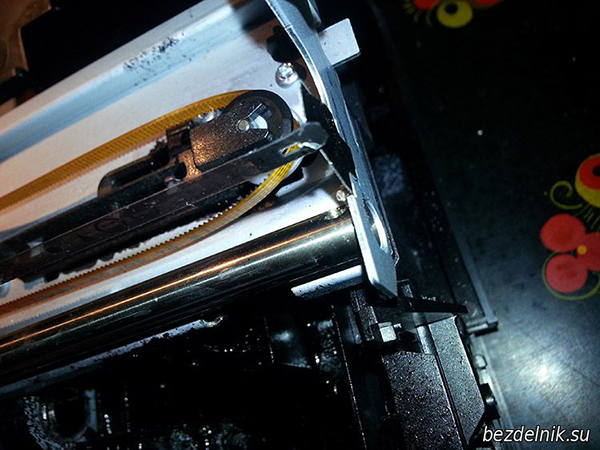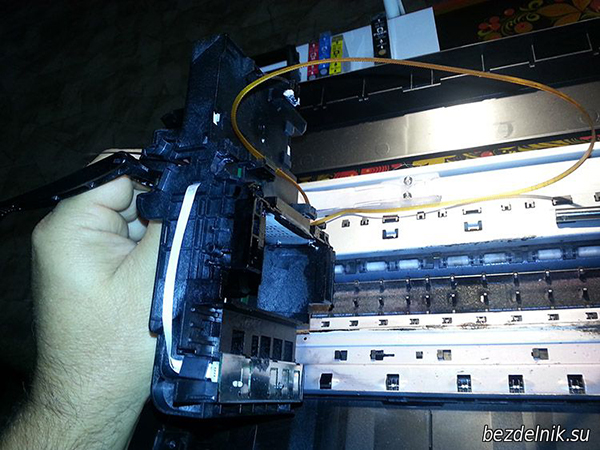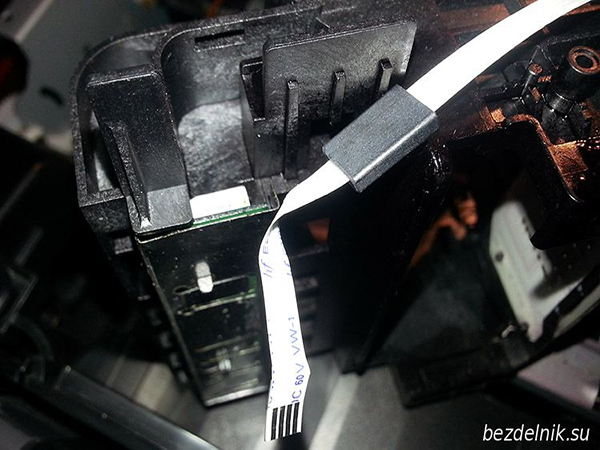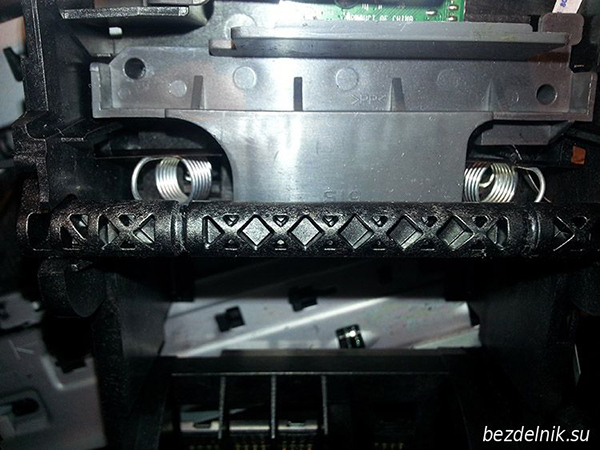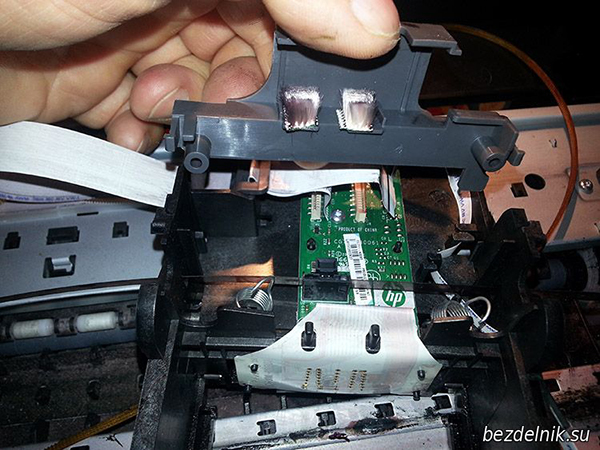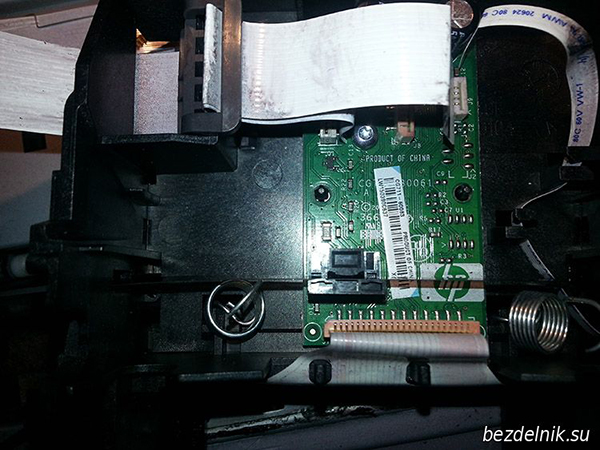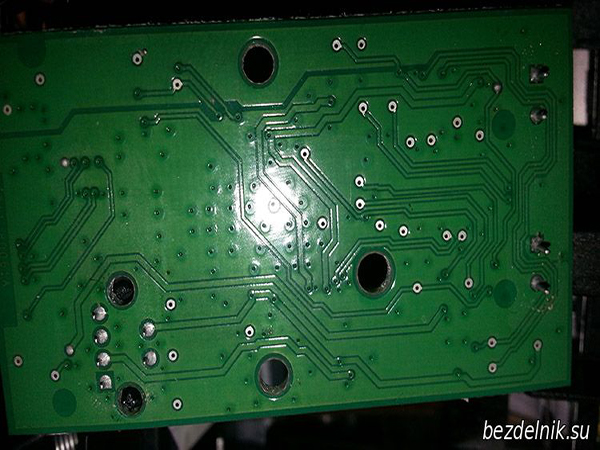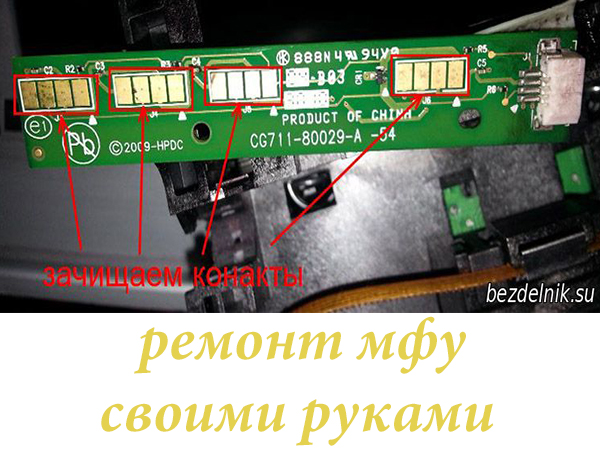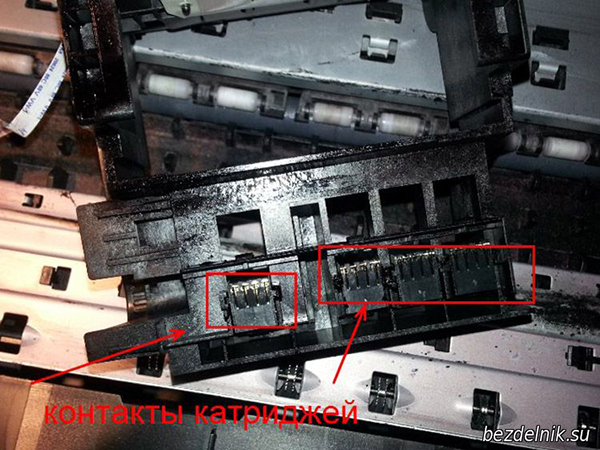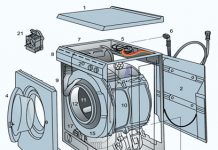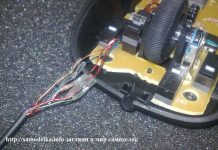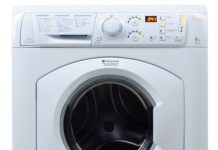This MFP was bought by me several years ago. I stopped at this model about the reason for the possibility of refilling cartridges. Specifically purchased a set of refillable HP178 ink cartridges (bought HERE ), as well as an OCP ink kit (bought HERE ). The overall impression of the HP B110B MFP is excellent. BUT. I don’t know how ordinary users use it, I have constant problems with repairs. Once I even turned to the workshop - they told me to throw it out. I've been throwing it out for about a year now. Super masters do not want to work even for money.
The main breakdowns in the HP B110B MFP are the loss of contacts in the carriage loops and loose contacts in the places where the cartridges are installed. The cost of printing is a penny. The print quality is excellent even with cheap ink. Several times I was trying to buy a new MFP, but ……HERE ... The installation of the head was also with dancing with a tambourine. Bottom line: it works to this day and most likely the old head was also good, but the problem is in the trains on the carriage.
Here's how to quickly disassemble the HP B110B MFP.
Reason for disassembly: HP B110B MFP DOES NOT SEE BLACK CARTRIDGE.
Lift the lid of the HP B110B MFP, the head will park in the lid open position.
We unscrew 6 screws and here is the first surprise. Two screws cannot be unscrewed just like that - the cover of the SCANNER UNIT interferes.
In addition to the screws, the side covers sit on 3 more latches on the bottom of the printer.
On the left side, after removing the cover, disconnect 2 white and black cables.
On the right side, unscrew the stopper fixing screw.
Lifting up, remove the scanner and put it to the side. We don't need it yet.
Now we have access to 2 problem screws. We wrap them up and remove the lid.
This is what the HP B110B MFP looks like from above. The head, carriage and cartridges are already available to us.
If the problem is not in the loops, then we continue the analysis of the HP B110B MFP. We remove the cartridges. We do not leave them open for a long time. I don’t use lids, because I’m working on disassembly with my eyes closed and they don’t have time to dry out. The same goes for the head.
If you are going to remove the head train, keep in mind that there is a movable silicone stop under the train. I forgot to take a picture of him.
To remove the carriage, loosen the toothed belt tensioner.
Remove the left and right cotter pins securing the carriage shaft.
We remove the shaft by pulling it out to the right.
We can now raise the carriage. Complete freedom of action.
We disassemble the carriage. To do this, release the head holder - remove 2 springs.
Remove the cover that covers the board. It has 2 latches and can be easily pry off with a screwdriver.
Unscrew 1 screw securing the printed circuit board. And we remove the fee.
Now we remove the cartridge contacts board. There are only 6 latches, 3 on each side. Spring plate keep this in mind.
We get access to the cartridge contacts board. In my case, the reason is precisely in this board. We clean up contacts
We check the moving contacts. They can be easily rearranged among themselves.
We assemble in the reverse order. The disadvantage of this assembly is that the loops are not fixed in any way. Thus, they bring unnecessary trouble to the owner of the HP B110B MFP.
This assembly - disassembly helps even if various ink system failure errors pop up:
From time to time, printer owners encounter malfunctions. Most people have independently acquired personal experience in eliminating the minor flaws of such a device.As practice shows, a frequent reason for the unwillingness of the printer to work may be a software failure or a minor malfunction in the mechanical part, which can be eliminated independently, without seeking help from a specialist.
Let's consider the probable causes of malfunctions and how to eliminate them on our own, without resorting to the help of another person.
The device of printers such as HP, Canon, Epson, Samsung, Sharp, Ricoh is fundamentally the same. Therefore, we will consider several reasons that are found on all printing devices:
Important! In no case should you use detergents and liquids containing alcohol.
In addition to all of the above, listen to the operation of your device. Are there any extraneous noises coming from it? If you hear them, this could be a signal that the gears that activate the printing mechanism are out of order. In most cases, they are made of plastic.
Below we will consider how to make repairs using the example of an HP LaserJet 1100 printer. This manual will also be useful for repairing Canon, Samsung and Epson printers.
Suppose the thermal film is damaged during printing with a paper clip on the sheet. For repairs, you need a small set of tools:
VIDEO
Important! During such work, each operation must be performed very carefully, since the printer is mostly made of plastic and any latch or part can break. Of course, after assembly, there should be no unnecessary parts.
Today, almost every family has a home printer that allows you to print documents and take photos from the comfort of your home. But, as you know, any office equipment needs maintenance and, if necessary, minor repairs from time to time. Therefore, in this article we will tell you how to do it yourself, at home, without much money and loss of time to troubleshoot printers. For example, consider the well-known brand - HP.
As you know, the Hewlett Packard brand is very popular in Russia. Printing devices of this brand can be found both at home and in businesses and offices. The high popularity is due to the reasonable price of printers and the reliability of their work. But any, even the most unpretentious device sometimes needs maintenance.
To begin with, let's look at the typical problems that arise with the active use of HP inkjet printers and how to solve them.
The first reason for possible malfunctions is internal contamination of the printer , leading to an imbalance of the moving parts, the formation of noise during operation and knocking during the movement of the carriage.
Even an ordinary user can fix this problem, the printer does not have to be disassembled - it is enough to buy a special lubricant sold in electronics stores and process all moving mechanisms.
To clean the printer from internal contamination, it is better to use ordinary distilled water; the use of alcohol for these purposes is contraindicated by the manufacturer.
If during printing the text moves to the side or the carriage hits the edges of the case - the reason may be dustiness or breakage of the positioning "ruler" , along which the carriage is oriented in space.
In the first case, you just need to disassemble the back of the printer, get to the shaft and remove the ruler, then rinse it in warm water, wipe it with a dry sponge and dry it, then put everything back in the reverse order (remember how the ruler was originally located) Turn on the printer and check its performance. If the line breaks, it is better to contact a specialized service center.
There is also another malfunction - the carriage does not cling to the gear teeth , the motor is idling. The cause of the breakdown is simple - poor drive belt tension. The problem is solved by inspecting and correcting the tension spring on the belt gear bracket. Perhaps it is poorly fixed or simply needs to be replaced.
The next problem is jerky movement of the carriage causing the printer to tear the paper. This is a serious malfunction associated with an imbalance in the printing mechanism - the printer shaft has lost its original correct position. To eliminate the defect, it is necessary to disassemble the printer - remove the carriage, ruler, shaft, toothed belt, clean all mechanisms by rinsing them in warm water, dry and collect everything in its original state, lubricating all friction points of the carriage and adjusting its free travel.
If your printer does not pick up the paper, for this it is worth cleaning the rubber rollers in the lower tray, and also adjusting the small spring that presses the paper against the roller.
If the printer produces a streak on the printed pages, you can safely say that the cartridge will soon run out, and to temporarily fix this problem, you just need to remove it and shake it from side to side.
If several horizontal stripes appear, you can clean the transroller yourself (black roller under the cartridge). It can be pulled out simply, but try not to touch it with your hands. You can clean the roller with cotton pads or a soft cloth, it is also allowed to use isopropyl alcohol.
Summing up, we can conclude that most printer malfunctions are eliminated by cleaning them from dirt and adjusting mechanisms even at home. Basic technical skills and patience are enough for this.
In this article, we'll look at common MFP problems and how to fix them. Repair tips are relevant for almost all MFP models - HP, Canon, Epson, Xerox, Brother, Samsung, Ricoh, Toshiba and others.
If the scanner unit breaks down in the MFP, then most likely it will not be possible to repair it at home. This may require replacing the backlight lamp or scanning head.
In principle, a malfunction of the scanning part of the MFP can be caused by breakdowns in the electronic part: it is necessary to check the capacitors for swelling, ring the power circuit with a multimeter, and also make sure that there are no burnt-out elements.
If there are problems with the printer unit, then it is usually not difficult to repair it at home.
Paper does not feed ... It is necessary to check the correct installation of the cartridge (this applies to both inkjet and laser MFPs), there are situations when a foreign object gets stuck in the paper path. It must be removed and checked for physical damage that it may have inflicted on the device.
The laser MFP may not print because cartridge chip not zeroed ... This can happen after refueling. In this case, you either need to contact the service center to replace the chip, or purchase a new cartridge. You can replace the chip yourself. To do this, you need to find and buy a new chip (they cost from 30 to 150 rubles), and insert it in the place of the old one.But for this you need to make sure that there is toner in the cartridge, otherwise replacing the chip is meaningless.
Stripes on sheets (laser MFP) ... In this case, you need to clean the drum unit. Remove the cartridge from the MFP, gently slide off the protective cap (on some models it may not be present). It is not recommended to touch the drum unit with your hands! Take a clean, dry, lint-free cloth and wipe off any waste toner from the drum. Then put the cartridge back in.
Printing Problems (Inkjet MFP) ... White spots, incomplete colors and other defects are common in inkjet MFPs. First you need to try to troubleshoot problems with software: cleaning the nozzles, calibrating the print head. If these steps do not help, then you can purchase liquid for flushing the nozzles of inkjet printers and clean it with it. Never use tap water, regular alcohol or other household products! You will only make it worse.
We hope that these repair tips were helpful. If anything, call, consultation - free!
The Master's Secret shares his successful experience in repairing a laser printer HP LaserJet 1010. The manual is suitable for HP LJ printers of the 1000 - 1200 series. The story is simple, the purchased used printer (for 1000 rubles) worked for a year and was stupidly damaged by a sheet with a paper clip, rinsed and began to rustle - it broke thermal film. Damage to the thermal film is easily confirmed by installing a replacement cartridge. Contacting the service center meant paying for repairs at least at the price comparable to buying a new printer. I also spurred the search for thermal film for the printer, sellers offered to buy thermal film at an unrealistic price of up to 1,500 rubles (its red price
100 rubles), plus the tricks of sellers in the absence of thermal grease in the repair kit and the sale of this component for repair also at an order of magnitude overpriced.
The thermal film was searched for within a month and was purchased for 300 rubles (2013) complete with thermal grease. Repair requires a simple tool:
The repair scheme is carried out step by step in the following order.
Step: 1 Check the integrity of the film and the presence of thermal grease. Pull the cartridge out of the printer. Unplug the power cord.
Step 1. Disconnect the power cord
Step 1. Remove the cartridge from the printer
Step: 2 The cartridge access cover is held in place by a rod. The stem must be separated from the cover by pressing on the inner edge of the plastic rivet. Hold the rivet while detaching.
Step: 3 Turn the printer towards you with the back cover and using a Phillips screwdriver, remove the three screws from the metal cover, two screws on the left and one screw on the right. See photo.
Step 3. Unscrew the screw on the left
Step 3. Unscrew the screws on the right
Step: 4 Remove the sides of the printer. The stacks are held in place by plastic clips that are located at the top, bottom, and back. The lid without buttons holds the strongest. Secret latches are shown in the photo.
Step 4. Wall latches with buttons
Step 4. Wall latches without buttons
Step: 5 Lift the cartridge access door and remove the two machine screws. Remove the cover.
Step: 6 Use a flat screwdriver to pry up the lower right edge of the metal back cover and remove it.
Step 6. Pry off the cover with a screwdriver
Step: 7 On the side of the power connector is the power board. There are four different connectors on the top of the board, unplug them. The connector with white thick wires will be disconnected only after pressing the latch, see the photo. It is also necessary to disconnect the red wire on the back panel. Just pull it up. Remember how it is fastened preloaded by a spring. Remove the wires from the organizer clips.
Step 7: power board connectors
Step 7. Latch for the fourth connector
Step 7. Fastening the red wire
Step 7. Red wire connector
Step 7. The wires are free
Step: 8 So we got to the stove. The stove is secured with three screws. See photo. We unscrew the screws. Hold the screws while loosening.
Step 8. The first screw that secures the stove
Step 8. The second screw securing the stove
Step 8. The third screw for fixing the stove
Step: 9 Take the right edge of the stove and pull it out.
Step: 10 Unscrew the two screws securing the stove top cover. Remove the cover by pulling it to the side.
Step 10. First cover screw
Step 10. Second cover screw
Step 10. The fuser cover is removed
Step: 11 Now we see the destruction of the thermal film. Remember the position of the planks with pins and levers! There are springs on the sides of the stove, we unhook the springs from below with long-nose pliers. We remove metal strips and plastic pressure levers on each side. Do not mix them up when assembling!
Step 11. Spring securing the lever
Step 11. Remove each spring
Step: 12 We release the white wires from the clips and remove the drum with thermal film. It just goes up.
Step 12. Remove the thermal drum
Step 12. The thermal drum is removed
Step: 13 We remove with our own hands the plastic tip from the side where thin wires come out of the drum. The cap is held on by the latches.
Step: 14 Remove the damaged thermal film and wipe the metal surface and the thermocouple with a damp cloth from old grease and dirt.
Step 14. Remove the thermal film
Step: 15 Apply a new thermal grease on the surface of the stove. Install the thermal film carefully. The end of the cylinder should be fixed to the opposite plastic tip. also carefully install the right tip. It is useful to remove leaked thermal grease.
Step 15. Apply thermal grease
Step 15. Putting on the thermal film
Step 15. Remove excess thermal grease
Step: 16 Assembling the stove in the reverse order. The correct position of the planks in the photo.
Step 16. The cover is installed
Step: 17 We put the stove in place and fasten it with three screws. We fill and connect all the wires to the connectors. Install the red wire correctly.
Step: 18 Install the back and top covers. Raise the plastic flags of the stove during installation. so that they fit into the corresponding grooves in the cover.
Step 19. Print a test page
Step: 19 After assembling the printer, we check the absence of unnecessary parts. We connect the power cord. We turn on the printer. First, we give the command to feed without paper, and then we print a test page, holding the green button a little longer. On the first few pages, grease marks may appear around the edges. The work was done unhurriedly for an hour. The money saved in such work will correspond to a salary of more than 100,000 rubles a month.
Repair such breakdowns yourself!
I myself changed dozens of thermal films for hp-I testify-it is written correctly.
And how to cheat a laser printer xerox 3140 I have a problem I bought a cartridge for it, I ran out of ink and started pouring new powder and then writes that there is supposedly no cartridge and the red diode has stopped printing and that's it / How not to tell him to cheat?
To prolong the life of your printer, you should perform annual maintenance on the printer itself. Also, this article will come in handy in case there is a need to repair the printer. The designs of inkjet printers are similar. Let's take an example of the HP D2663 inkjet printer.
How to open the printer. Three screws for fixing the cover are easy to find, but the fourth screw is hidden under the control button.
Gently pry on the button with a screwdriver and take out the button from its seat (do not lose the light guide, it will fall out of the button).
This is where the fourth screw is. Without knowing this, they usually break the cover of the printer.
Other useful information:
wrote in the forum: Question - answer: Olga on: 09/17/2018
wrote in the forum: Question - answer: Dmitry on: 03/25/2018
wrote in the forum: Question - answer: Sanya on: 07/12/2017
Today, almost every family has a home printer that allows you to print documents and take photos from the comfort of your home. But, as you know, any office equipment needs maintenance and, if necessary, minor repairs from time to time. Therefore, in this article we will tell you how to do it yourself, at home, without much money and loss of time to troubleshoot printers. For example, consider the well-known brand - HP.
Have you ever faced the need to repair your printer? God forbid, of course, but still. What did you do in this situation? I bet that most of them donated their devices to service centers or workshops. This is where the main question comes up - is the repair worth that kind of money? Perhaps the problem could have been fixed at home. I want to warn you right away that you cannot get rid of all breakdowns yourself. If, for example, the motor is covered or the gear is broken, then you want it or not, but you will have to take it to smart uncles. And one more “but”. People who cannot tell the difference between a slotted screwdriver and a Phillips screwdriver should not read the article. To carry out the actions described below, you need a pair of hands growing from the right place, otherwise there is a high probability of making it even worse. So let's start with general phrases and end with specific examples. Based on personal experience, I want to note that the electrical part of printers rarely breaks down. Basically, the mechanics or the mechanism of the head fails. In the latter case, there is practically no hope of self-repair.
To begin with, let's look at the typical problems that arise with the active use of HP inkjet printers and how to solve them.
The first reason for possible malfunctions is internal contamination of the printer, which leads to imbalance of moving parts, noise during operation and knocking when moving the carriage.
Even an ordinary user can eliminate this problem, the printer does not have to be disassembled - it is enough to buy a special lubricant sold in electronics stores and process all moving mechanisms.
To clean the printer from internal contamination, it is better to use ordinary distilled water; the use of alcohol for these purposes is contraindicated by the manufacturer. If during printing the text moves to the side or the carriage hits the edges of the case - the reason may be dustiness or breakage of the positioning "ruler" along which the carriage is oriented in space.
In the first case, you just need to disassemble the back of the printer, get to the shaft and remove the ruler, then rinse it in warm water, wipe it with a dry sponge and dry it, then put everything back in the reverse order (remember how the ruler was originally located) Turn on the printer and check its performance. If the line breaks, it is better to contact a specialized service center.
The presence of elementary dirt in the printer can lead to some problems, including: extraneous noise in the device, imbalance in the mechanism, the printer does not grab paper or the carriage, moving with a knock and beating against the edge of the case. Printer cleaning lubricant is available from any electronics store. Never clean the printer with alcohol, it is better to use distilled water. The fact is that alcohol can damage fine and small parts. In addition to water, you will need a screwdriver, a foam sponge and a dozen cotton swabs.
There is also another malfunction - the carriage does not cling to the gear teeth, the motor is idling. The cause of the breakdown is simple - poor drive belt tension. The problem is solved by inspecting and correcting the tension spring on the belt gear bracket. Perhaps it is poorly fixed or simply needs to be replaced.
Carriage breakdowns are easier and faster to fix than other problems. The printer will not even need to spin up. One of the main parts of the carriage is a transparent ruler with which the printer is oriented. The stability of the carriage is influenced by the degree of dustiness of this line. Turn off the printer, remove the case and take out the ruler, just be sure to remember the position in which the ruler was located. Rinse the ruler in warm water and dry, then reattach it to the printer.
The next problem is jerky movement of the carriage causing the printer to tear the paper.This is a serious malfunction associated with an imbalance in the printing mechanism - the printer shaft has lost its original correct position. To eliminate the defect, it is necessary to disassemble the printer - remove the carriage, ruler, shaft, toothed belt, clean all mechanisms by rinsing them in warm water, dry and collect everything in its original state, lubricating all friction points of the carriage and adjusting its free travel.
If the carriage does not move smoothly, but intermittently, or the printer breaks the paper, this means that there is an imbalance in the printer mechanism. To fix this problem, first turn off the printer, remove the case, and remove the ruler. Next, remove the gear strap attached to the gears. Unscrew the screws located on the back of the shaft. Clean the shaft and correct the unbalanced elements. Then you can reassemble the printer.
If your printer does not pick up the paper, for this it is worth cleaning the rubber rollers in the lower tray, and also adjusting the small spring that presses the paper against the roller.
If the printer produces a streak on the printed pages, you can safely say that the cartridge will soon run out, and to temporarily fix this problem, you just need to remove it and shake it from side to side.
If several horizontal stripes appear, you can clean it yourself transroller (black roller under the cartridge). It can be pulled out simply, but try not to touch it with your hands. You can clean the roller with cotton pads or a soft cloth, it is also allowed to use isopropyl alcohol.
Summing up, we can conclude - most printer malfunctions can be eliminated by cleaning up dirt and adjusting mechanisms even at home. Basic technical skills and patience are enough for this.
Some printer problems can be resolved at home. Although, of course, not from everyone, then it is better to contact the service center. This advice can also be followed by people who cannot tell the difference between a Phillips screwdriver and a slotted screwdriver.
If it was not possible to eliminate the malfunction at home, then contact the professionals at the service center.
Hello everyone! After my previous post about repairing printers, I still have +10 subscribers) Although I do not pretend to be such respected pikabushniks as qepka and 80cats (I am far from them and their work profile is different), I am very pleased for your support. In this post I want to tell and show you about the repair of some printers that have visited our SC
Xerox WC3220, problem - after turning on it does not go on readiness, a message appears something like “system error: off / on. a printer". I also thought that everything is simple because with the same error, the same printers have already brought, the result - the heating lamp burned out. I noticed that recently they began to bring Sam / Xer printers with a burned out lamp, it seems to be understandable: it often turns on and off during operation (it was just that this was not the case before, and devices of about the same year of manufacture ¯_ (ツ) _ / ¯ ) During the repair process, it turned out that the lamp and the fuses were intact, and the reason was not a contact in the thermo unit connection socket:
Looks like the face of a robot with square eyes) The “teeth” of the robot are the contacts of the thermal sensor, the “eyes” are the contacts of the lamp. Two pins were just a little covered with oxides, I was too lazy to clean them and I put the whole socket from another disassembled thermo unit.
Next, the Canon LBP3110 printer, the problem is crackling when printing, jams. And here is a typical problem - wear of the drive gear of the thermal unit:
In the photo, another printer seems to be Canon MF5730, exactly the same gear in HP 1000/1200/1300 printers and many others
Instead of teeth, the gear has thin plates, of course, there is no normal engagement with the gear of the rubber shaft of the thermal assembly. I think there are several reasons for this wear: different gear material, weak pressure between the gears, wear of the thermal assembly, and the manufacturer himself is not interested in the nodes to serve for a long time
Kyocera ES 1370N printer. Customer complaint that the sheet comes out of the printer by about 2-3 cm and stops.This happens in about 5-15 sheets.
I found out that the Teflon shaft was worn straight to the metal on one edge, but after replacing it, the malfunction remained. Having crawled through the forums on this problem, I realized that either the optocoupler for the passage of paper in the thermal unit is faulty, or the forward / backward rotation switch of the output shaft is damaged (with double-sided printing). I checked all this - the problem remained. Further, suspicion fell on the registration clutch in the gearbox. It is a pity that then I did not take enough pictures because my hands were constantly greased from gears (there is a mechanism that is not easy to disassemble)
Further repair of НР Р2035. They printed until the last: after the thermal film broke, the rubber shaft broke, they stopped only when the printer began to jam the paper, the result: repairs for something about 3000 rubles, and it could be more if the heating element burned out (gray strip on photo) The photo shows that even the paper turned black from the temperature
If you open the rear door of the printer after a paper jam and notice such pieces of rubber roller or thermal film (sometimes they fall into the tray or at the exit from the printer), then turn off the printer and carry it to repair so that you will not spend even more on repairs.
Often, in HP / Canon printers, it is necessary to replace the bearings (bushing) of the rubber shaft of the fuser unit. They are made of heat-resistant plastic, in shape they can be left and right as half rings or one half ring, and the other on the gear side of the rubber shaft with a loop from scrolling in place.
Ball bearings familiar to many are also put into printers, but the price of such devices is usually several times higher. In the upper right corner of the photo, it broke when trying to get it - it was completely erased. Often they wear out unevenly, in which case a skew arises and the thermal film slides towards the worn one and over time its edge breaks. Also, when they wear out, the clamp between the rubbers. the roller and the heating element becomes smaller, which is why the toner does not adhere well to the sheet (the image is erased if you slide your finger over it). On the left side of the photo are two red bearings from canon 3110/3220/5730 and similar. The trick is that the one that is higher in our country is around 200 rubles, and with a loop it is already almost 900 rubles. (!) The wholesale price will certainly be lower, but still I do not understand what exactly is its high price, can any of the pikabushniks know?
The next Brother 7xxx series printer seems to be and the most common problem is poor print quality. It happens that a client calls and asks: “What’s the matter with my printer”, and I just want to answer - fucked. Well, I don't like these printers, my parents have a DCP-7030R at home, my father rarely prints and all the rules, and in an organization where you need to print a lot, they constantly bring them with poor print quality. When I just started working in the service I tried to somehow fix the cartridge, clean it there, replace the photo tube, sometimes it seems to help, but more often, or when checking, it will do the same thing again, or then a dissatisfied client will bring it again. The most reliable thing is to buy a new cartridge stupidly and not to steam. Moreover, the compatible cartridge is not much worse than the original, and the price is 3 times less
The cartridge itself consists of two parts: a toner cartridge (TN) and a photo cartridge (Drum). The photo shows a disassembled Drum without a photo. In general, cartridges themselves are consumables and manufacturers try to make them disposable in their own way, because this is just a gold mine for them. Someone, for example, puts chips with protection, which are blocked after printing a certain number of sheets, and Brother uses a mechanism instead of chips, which, in principle, is easy to reset to 0, in addition, they took some parts from the printer into the cartridge and made it as disposable as possible ... On average, 4-5 refills and the toner cartridge starts to crumble, and then the dram starts to print badly. As I said before, cleaning and repairing the cartridge does not always help. You can clean the toner cartridge (completely empty out the old toner, invigorate the seals, clean the magnetic roller, metering and cutting blade), but with the drum it is more difficult.As we understood, charge leakage begins and that's it.
Next comes the HP M400 printer - another example of how a manufacturer strives for disposable cartridges. Customer complaint: the printer breaks the teeth of the drive coupling for rotation of the photo roll (by the way, the cartridges are original)
Fortunately, the clutch is available, and it can be removed from the decommissioned ones. The trick is that on previous models with the same fotoval drive unit, such garbage was not observed. If you pull out / insert the cartridge, the printer starts to rotate the shafts, but sometimes the clutch slips and eventually the clutch breaks. I had to work on a collective farm with a gear cover so that the clamping of the clutch and the drives was tighter)
True, then, after about 3-4 months, the client brought it again with the same trouble (and they print a lot). There are no further kolkhoz photos - another person took up the printer. In addition to this jamb, the printer has a dull touch display and log firewood - you wait almost an hour for installation, it reaches 99% and an error occurs that the installation takes too long, restart the computer (if there is firewood installed on the same printer, remove them completely and start the installation again)
Further on the list of MFP Toshiba e18. Quite a popular model with a reasonable price for an A3 paper machine. The client says he is jamming the paper in the fuser with an accordion. The customer is to blame for this - when a jam occurs, the paper must be removed carefully, otherwise the seats of the paper separation fingers can be easily broken:
You can, of course, try to fix it with a thin drill, wire or paper clips (if you glue something, then with a special high-temperature glue, which we do not have 🙂), but in such cases we usually suggest replacing the entire lid of the thermo unit, there is no other way. If the printer displays a message about the need for service (after about 75 thousand pages) and the print quality suits you, the error can be easily reset, but still sometimes you look inside to see if everything is okay with it. By the way, I recently screwed up a lot with another Toshiba) I replaced the Teflon shaft, began to assemble it back, and at the stage of tightening the fastening screws of one of the heating lamps pulled my hand that broke the tip with the contact of the lamp (I'm a fool, I'm used to using an electric screwdriver, but it was necessary to tighten the usual one carefully) Naturally, there is no way to repair it, and the lamps removed from the old devices have disappeared somewhere. Fortunately, the boss did not swear much, advised him to look into the thermo unit of the old decommissioned model of Toshiba, which had been standing in the corner for a long time. I was lucky - although there was only one lamp, instead of two in the 18th one, it matched the parameters of the broken one.
That's all for today, I think it's time to finish) Why didn't I have inkjet printers in my post? There was a time when our service refused to repair them altogether. there was little exhaust from them. Recently, they decided to take them again, but only to eliminate problems not related to print quality - this is a dirty business, and there is no guarantee of work (at most, start cleaning the nozzles). Usually we reset errors, remove jams, change pick rollers, “diapers” and so on. Instead of cats at the end - fsh with Pikabu from which I blasted out loudly at work: Mitka Makkonokhov and Zhorik Letov
What I liked while working in the SC was the repair of printers / copiers. Although I started with a banal PC repair, then laptops, navigators, etc. As a result, I slowed down on the printer equipment, and for the last three years I have only been repairing it. Now I will explain a little to those who do not know:
1. It is much more interesting (and even more difficult) to repair a printer than computers and laptops (it’s not just me about laptop BGA soldering, etc. a child can handle soldering at a thermal soldering station).
2. Variety of breakdowns, each printer is something new and a drop of experience. Yes, there are repetitive repairs, but their percentage is not as large as when repairing PCs / laptops.There are instances (immediately the cold ran through the body) with which you f * ck for several days and knowing exactly the node in which the malfunction (from personal experience - SHARP, I picked it up for three days, as a result - on the gear already when measuring the gear it turned out that the teeth were licked evenly by 1 - 1.5 mm.) For 10 years of work experience in the SC, I have not yet seen a single laptop and PC which would take more than 2-3 hours to diagnose.
3. Each printer is endowed with a magical mind. And if you do not say at the end of the assembly and before the test check the phrase: “Well, bitch, just try to fuck, I won’t fucking disassemble you for the third time” - then there is a possibility that I didn’t finish something. The most important thing is communication with the printer, you have to feel it so to speak. (to know, in which case, in which area to get off the feet) .
4. Incredible thrill when everything works. Especially the buzz is obtained from the repair of the mechanical part (there is the fiercest pi * ets just ).
5. Copiers (these are such big hellish office machines) are the raisins for an employee of the SC. Since this is the same printer, only there are more details - ask where are the raisins? For the price of repair, they are charged 10 times more expensive.
Video (click to play).
And finally, I would like to end with the following phrase: you can't just pick up and assemble so that there are no extra bolts left .

